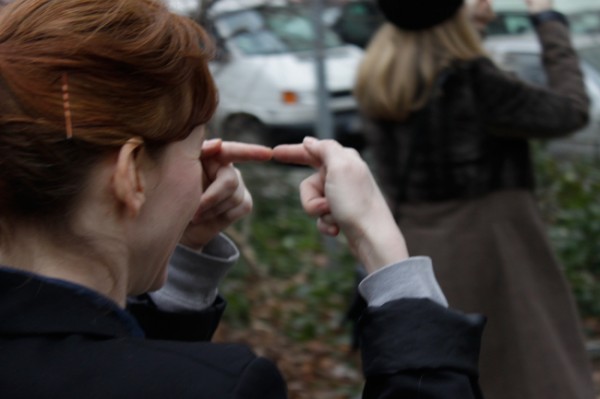
In Honor of Trisha Brown: Balance Walk (Leaning Duets)
Balance Walk (Leaning Duets by Trisha Brown)
Balance Walk
In honour of Trisha Brown:
Find a partner, join hands and maintain a balance by tilting away from the other in an angle, composing a V, while the edges of your feet meet in the center. Take tentative steps in the same direction.
Trisha Brown’s Leaning Duets (1970) is a test of balance and trust, representing her experiments with capturing physical laws of momentum, gravity and equilibrium.
Balance Walk (Leaning Duets by Trisha Brown)
Balance Walk
In honour of Trisha Brown
Finde einen Partner, haltet Euch an den Händen und stellt zwischen Euch die Balance her, indem Ihr Euch nach außen lehnt – ein V bildend – während sich die Kanten Eurer Füße bei jedem Schritt in der Mitte treffen. Geht vorsichtig in die gleiche Richtung.
Trisha Browns Leaning Duets (1970) ist eine Übung zu Balance und Vertrauen und stellt eines ihrer Körper-Experimente dar, das physikalische Gesetze des Momentums, der Schwerkraft und des Gleichgewichts ausloten.
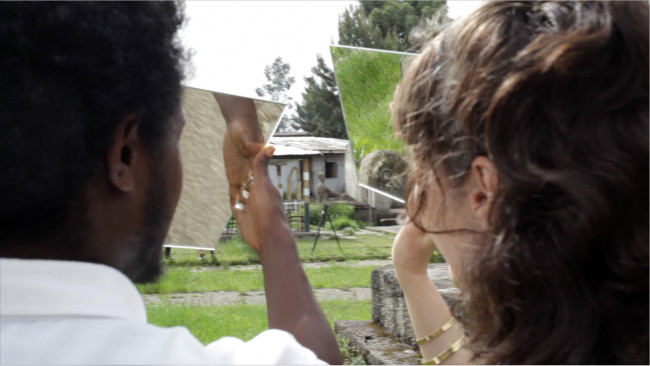
See Walk (Variation II)
See Walk (Variation II)
with Thilo Frank and Christina Werner
Alle School of Fine Arts and Design, Addis Ababa
As performed in See Walk, use a mirror to reflect on where you are going. In the two-person variation, find where you are going using someone elses reflection. Self-organize a choreography of slowness and seeing so that each person is simultaneously holding the other persons: way of seeing, where you are looking, where you are going, and how you get there together.
See Walk (Variations)
—
Acting Archives is a project by the Institut für Raumexperimente, Berlin University of the Arts and the Alle School of Fine Arts and Design, Addis Ababa University, supported by Studio Olafur Eliasson, and funded by the TURN Fund of the German Federal Cultural Foundation.
See Walk (Variation II)
mit Thilo Frank und Christina Werner
Alle School of Fine Arts and Design
Addis Abeba
Benutze wie beim See Walk einen Spiegel um Dich zu orientieren und zu sehen wohin Du gehst. In der Variante für zwei Personen benutzt jeder von Euch jeweils die Reflektion im Spiegel des anderen, um zu sehen wohin Ihr geht. Findet eine selbstorganisierte Choreographie von Verlangsamung und Orientierung, so dass jeder den anderen mit führt: wie Ihr seht, wohin Ihr schaut, wohin Ihr geht und wie Ihr dort hingelangt.
See Walk (Variations)
—
Acting Archives ist ein Projekt des Instituts für Raumexperimente der Universität der Künste Berlin und der Alle School of Fine Arts and Design, Addis Ababa University, unterstützt durch Studio Olafur Eliasson, gefördert im Fonds TURN der Kulturstiftung des Bundes.
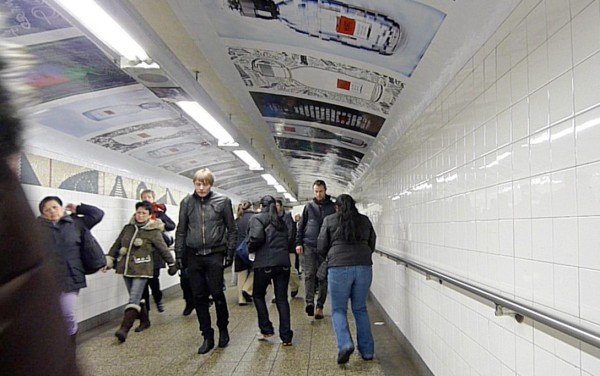
Slow Walk
Walk: Slow WalkAs a group, walk very, very, very slowly for 15 minutes in public. Feel your weight on the ground. Feel your balance shift. Feel each part of the slow motion as it is distributed though your entire body. Don’t forget to breathe.
Walk: Slow Walk (Variation I)Walk very very very very slowly with a group of people walking very very very very very slowly.
Walk: Slow Walk (Variation II)Walk very very very very slowly.
Walk: Slow WalkGeht als Gruppe ganz, ganz, ganz langsam für 15 Minuten im öffentlichen Raum. Spüre Deine Gewichtsverlagerung bei jedem Schritt. Spüre wie Deine Balance sich verschiebt. Spüre wie jeder Moment des verlangsamten Bewerbungsablaufs sich auf Deinen gesamten Körper auswirkt. Vergiss nicht zu atmen.
Walk: Slow Walk (Variation I)Gehe sehr sehr sehr sehr langsam in einer Gruppe von Leuten, die sehr sehr sehr sehr sehr langsam geht.
Walk: Slow Walk (Variation II)Gehe sehr sehr sehr sehr langsam.
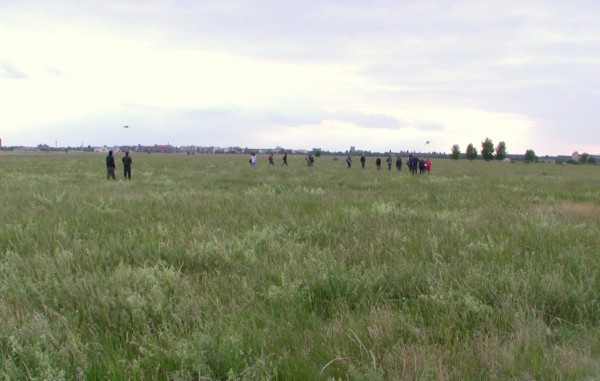
Fukashi Walk
Pick a word or characters which has some significance to you. With a group of people, try to walk those letters or characters in a large scale and in a public space. Walk those letters or word over and over until you become the word you make.
Fukashi Walk, with Nina Fischer & Maroan el Sani, 14 June 2012
Wähle ein Wort, das für Dich von Bedeutung ist. Stell Dir das Wort in großem Maßstab vor und laufe die imaginären Buchstaben des Wortes mit einer Gruppe von Leuten ab. Erlauft Euch diese Buchstaben oder Worte bis Ihr zu den Wörtern werdet, die Ihr bildet.
Fukashi Walk, mit Nina Fischer & Maroan el Sani, 14. Juni 2012

Your Attention Span Walk
Walk: Your Attention Span WalkOn your way to somewhere else, focus on something around you. Look only at that thing. Think about nothing other than that thing. Let all other thoughts pass through you. When you arrive at that thing, pick another thing to focus on. Keep doing this over and over for some time.
Walk: Your Attention Span WalkFokusiere etwas in Deinem Blickfeld während Du irgendwohin gehst. Betrachte nur dieses. Versuche an nichts anderes zu denken. Lass die anderen Gedanken vorbei ziehen. Wenn Du die gewählte Stelle passiert hast, suche Dir einen neuen Fokuspunkt. Wiederhole das wieder und wieder während Du weiter gehst.
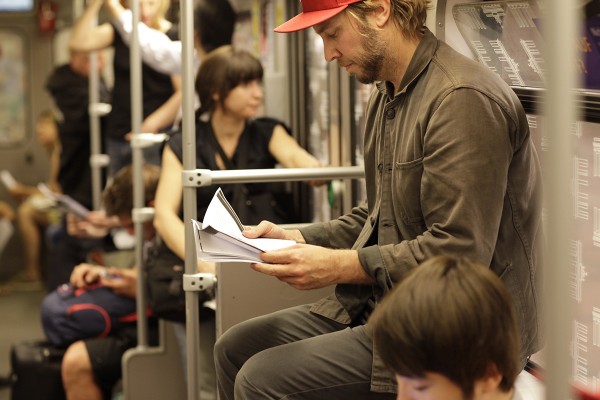
Take a Stand Walk
Sit down while traveling on a form of public transportation. At some moment on the way, take off your shoes. Stand up in the place you are asked to sit. Keep standing there for some time while just being yourself.
Fahre mit öffentlichen Verkehrsmitteln und setzt Dich während der Fahrt auf einen freien Platz. Irgendwann ziehst Du die Schuhe aus. Stelle Dich auf Deinen Sitzplatz. Stehe dort für eine Weile. Sei Du selbst.
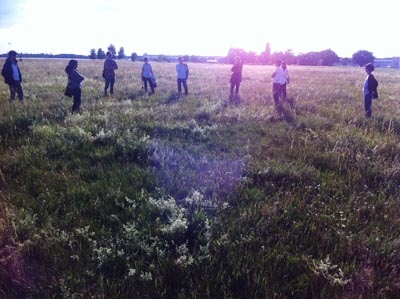
Sound Walk (Circle)
Start standing in a circle in a public space. Walk away from each other along different radii while saying “hello” to the people standing across from you. Keep walking your radius and screaming hello until you can no longer hear a “hello” from anyone in your circle saying hello. Walk back to the center saying hello.
Designed by Eric Ellingsen, Christian Hawkey & Sharmila Cohen
Bilde mit mehreren Teilnehmern einen Kreis. Sage “Hallo” zur Person, die Dir im Kreis gegenübersteht und enferne Dich langsam rückwärtsgehend von ihr. Vergrößere den Abstand und damit den Kreisradius und rufe lauter “Hallo” bis du das “Hallo” der anderen Personen im Kreis nicht mehr hören kannst. Laufe zurück zum Kreismittelpunkt und sage “Hallo”.
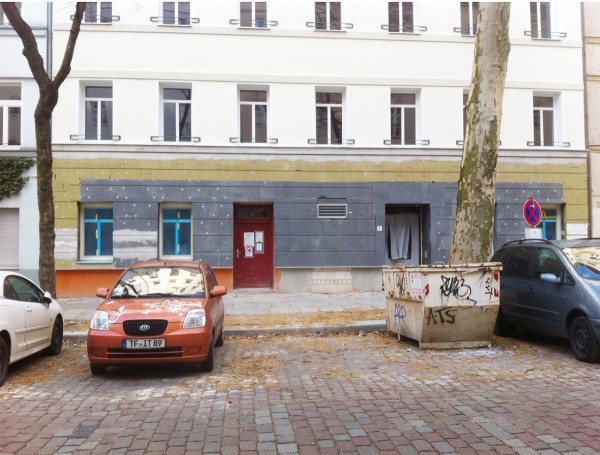
Estimation Walk (Variation II)
Walk: Estimation Walk (Variation II)Pick something around you and guess how many footsteps it would take between where you are standing and that thing. Walk that number of footsteps to that thing. Keep doing this for some time. Designed by Vito Acconci, reenacted by Eric Ellingsen. Performed with Sanford Kwinter and Graduate School of Design, Harvard
Walk: Estimation Walk (Variation II)Wähle eine Gegenstand oder einen festen Bezugspunkt aus und schätze wieviele Schritte Dich von diesem trennen. Gehe die geschätze Anzahl von Schritten darauf zu. Wiederhole dies für eine gewisse Zeit.
Konzipiert von Vito Acconci, wiederholt von Eric Ellingsen. Ausgeführt mit Sanford Kwinter und der Graduate School of Design, Harvard University
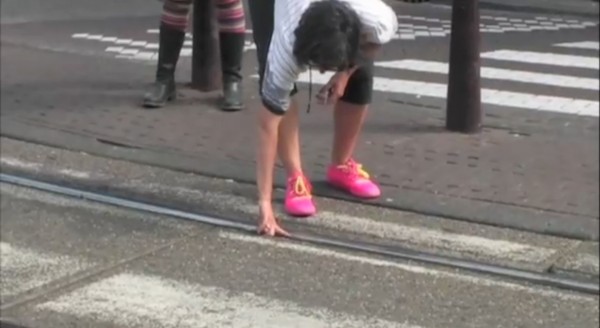
Measure Walk
Walk: Measure WalkIn public space, pick something at eye level or below, that is within easy walking distance. Estimate the size of that thing using your fingers and arms. Hold that measurement with your fingers or arms and walk to that thing. Keep doing this for some time.
Designed by Eric Ellingsen and Alvaro Urbano
Walk: Measure WalkWähle einen Gegenstand auf Augenhöhe oder darunter, der in an angemessener Distanz zu sehen ist. Schließ ein Auge und miss die Größe des Gegenstands mit Daumen und Zeigefinger. Halte diesen Messabstand von Daumen und Zeigefinger bei und nähere Dich dem Gegenstand bis Du ihn berühren kannst. Wiederhole dies für beliebige Zeit.
Konzipiert von Eric Ellingsen und Alvaro Urbano
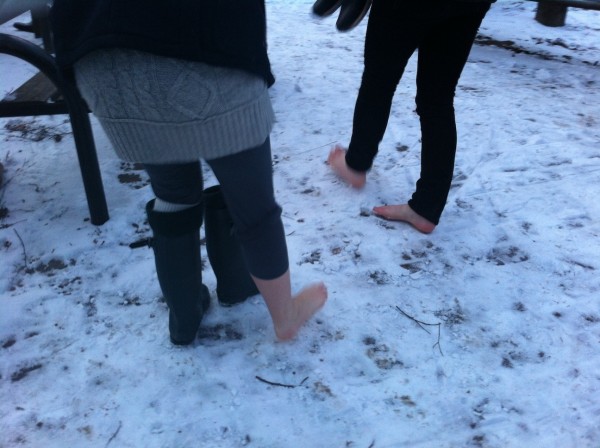
Barefoot Walk
In the middle of winter, with ice or snow on the ground, find a place in public a few hundred meters from a warm inside environment. Take your shoes off. Walk until you start loosing the feeling of your connection to the earth, then walk inside. Have towels and mildly warm water waiting for your feet.
Designed by Eric Ellingsen and Christina Werner
Performed with Sanford Kwinter and Graduate School of Design, Harvard University
Wenn im Winter der Boden mit Eis oder Schnee bedeckt ist, suche einen dem warmen Haus nahegelegenen, öffentlichen Ort. Ziehe deine Schuhe aus und laufe solange barfuß, bis du das Gefühl verlierst, mit der Erde verbunden zu sein. Kehre dann ins Warme zurück. Halte Handtücher und warmes Wasser für deine Füße bereit.
Konzipiert von Eric Ellingsen und Christina Werner
Ausgeführt mit Sanford Kwinter und Klasse Graduate School of Design, Harvard University
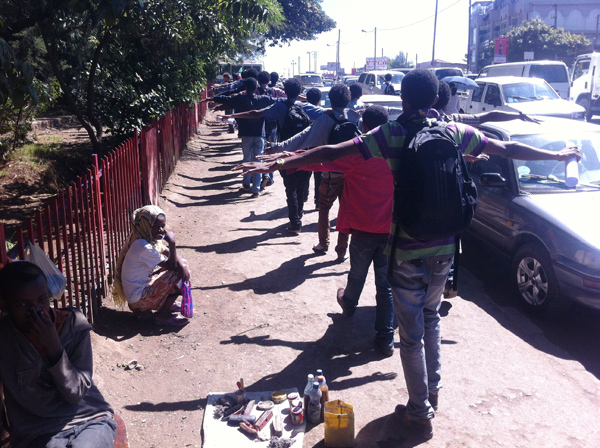
Periphery Walk
Put your hands out to your side until you see your hands disappear. Keeping your hands at the boundary of your peripheral view, and keeping your head pointed straight while focused on your sides, walk through a part of the city.
Designed by Eric Ellingsen; Performed by EiABC, Ethiopian Institute of Architecture, Building & Construction
Strecke deine Arme soweit seitwärts aus, dass du deine Hände verschwinden siehst. Halte die Hände an der Peripherie deiner Sicht und den Kopf nach vorn gerichtet während Du die Seiten fokussierst. Laufe so durch die Stadt.
Konzipiert von Eric Ellingsen; Ausgeführt mit EiABC, Ethiopian Institute of Architecture, Building & Construction
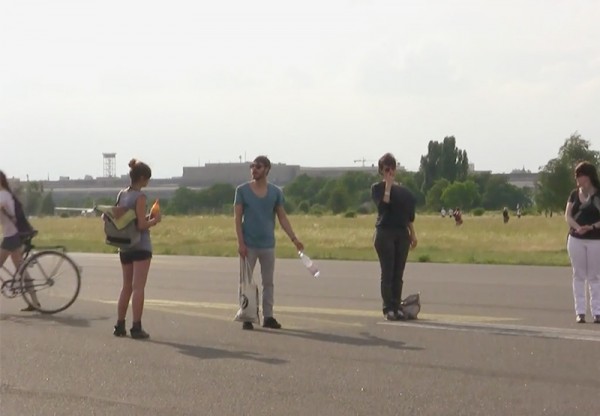
Estimation Walk (Line, Variation I)
Estimation Walk (Variation I)Define a distance of 100m. The group starts walking, everyone walks in the same direction and stops after what they think is 100m.
Designed by Eric Ellingsen and Christina Werner
Estimation Walk during Pre-Life-Is-Space-Marathon, 16 June 2011
Estimation Walk (Variation I)Lege eine Distanz von 100 m fest. Die Gruppe startet gemeinsam, alle gehen in dieselbe Richtung. Jeder stoppt, wenn er denkt, dass er 100 m weit gegangen ist.
Konzipiert von Eric Ellingsen und Christina Werner
Estimation Walk, Pre-Life-Is-Space-Marathon, 16. Juni 2011
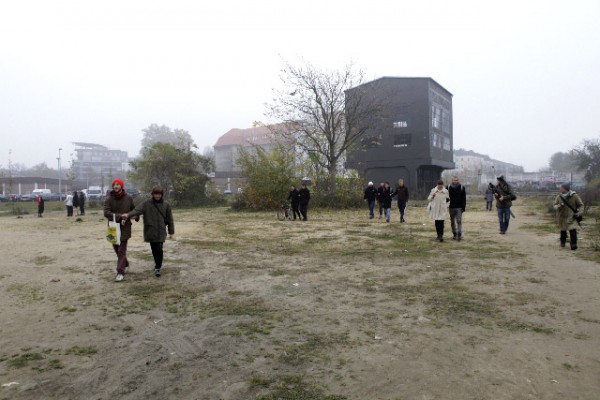
Blind Walk
Blind WalkStart in a place that is unfamiliar. One person is blindfolded; one person guides. Start walking. The blindfolded person tries to make a loop back to where you started walking.
Designed by Eric Ellingsen & Christina Werner
Blind Walk (Variation I):Work as a team of two: one person is blindfolded; one person wears earplugs. Start walking, one guiding by sound, one by sight.
Blind Walk, during Pre-Life-Is-Space-Marathon, 16 June 2011
Blind WalkStartet an einem Euch unbekannten Ort. Eine Person hat verbundene Augen, eine Person führt. Lauft los. Die Person mit verbunden Augen versucht einen Bogen zu schlagen und zum Ausgangsort zurückzufinden.
Konzipiert von Eric Ellingsen & Christina Werner
Blind Walk (Variation I):Bildet einer Zweierteam: Eine Person hat verbundene Augen, ein Person benutzt Ohrstöpsel. Lauft los. Einer führt sehend, der andere führt hörend.
Blind Walk, Pre-Life-Is-Space-Marathon, 16. Juni 2011
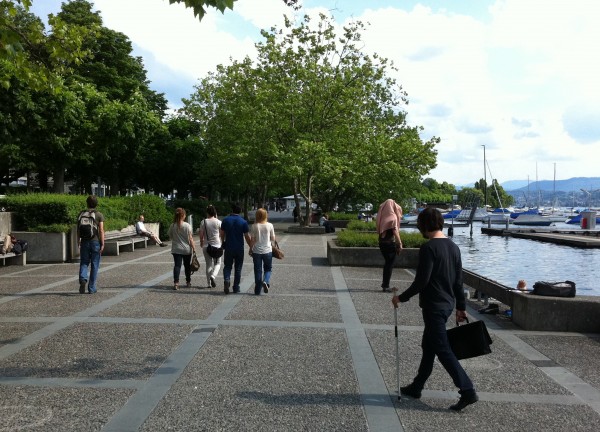
Diagonal Walk
Diagonal WalkIn a public space, walk only diagonal lines to get to a place 1km away.
Designed by Eric Ellingsen & Christina Werner & Friederike Hörbrügger
Diagonal Walk, Zürich, 17 May 2011
Diagonal WalkGehe in diagonalen Linien durch den Stadtraum zu einem Ort, der einen Kilometer entfernt liegt.
Konzipiert von Eric Ellingsen & Christina Werner & Friederike Horbrügger
Diagonal Walk, Zürich, 17. Mai 2011
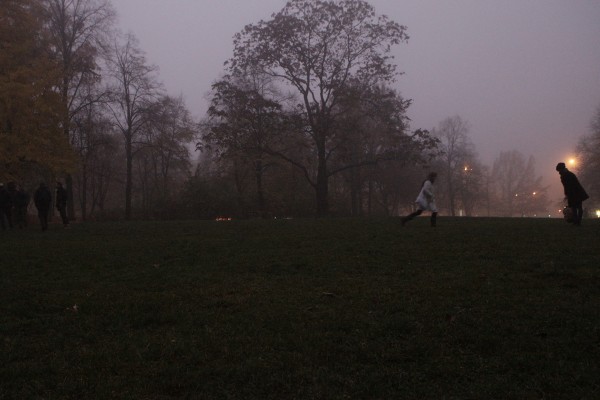
Estimation Sound Walk
In groups of two to five people, ask one person to stand still and close their eyes. Ask the others to stand next to the person with their eyes closed. Ask them to say here. Counting their footsteps, ask them to walk some distance away from the person standing still with their eyes closed, and then to stop. Ask them to say here again. Note, the person saying here should say the word with the same volume as they said it the first time. Have the person with their eyes closed guess how far away they have gone and to point to where they are.
Designed by Eric Ellingsen and Christina Werner
In einer Gruppe von zwei bis fünf Personen schließt einer die Augen. Die anderen stellen sich direkt um diese Person herum, jeder von ihnen sagt nacheinander „Hier“ und entfernt sich dann um eine beliebige Schrittzahl von der Person in der Mitte und wiederholt dann ein „Hier“ in der gleichen Lautstärke wie zuvor. Die Person mit den geschlossenen Augen rät wieviele Schritte sich die anderen jeweils entfernt haben und zeigt noch immer mit geschlossenen Augen an, wo die anderen jeweils stehen.
Konzipiert von Eric Ellingsen und Christina Werner
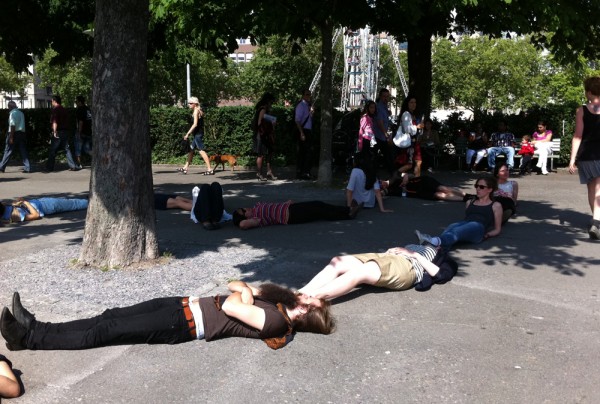
Lay Down Line Walk
Lay Down Line WalkWith a group of people, lay down in a long line, head to toe, in a public space. Starting at the head of the line, ask the last person to stand up and run or walk to the other end of the line and lay down. Ask the new last person to stand up and walk or run to the end of the line. Repeat this with each end until everyone has walked or run at least three times.
Designed by Eric Ellingsen & Christina Werner
Performed with Institut für Landschaftsarchitektur ETH Zurich
Lay Down Line Walk, Zürich, 17 May 2011
Legt Euch in einer Reihe – Kopf an Fuß – im öffentlichen Raum auf den Boden. Die letzte Person in der Reihe, steht auf und rennt oder geht zum Anfang und legt sich dort hin. Die nun letzte Person steht auf und läuft zum Beginn der Schlange und legt sich der Länge nach hin. Wiederholt das solange bis jeder mindestens drei an der Reihe war.
Konzipiert von Eric Ellingsen & Christina Werner
Durchgeführt mit dem Institut für Landschaftsarchitektur ETH Zurich
Lay Down Line Walk, Zürich, 17. Mai 2011
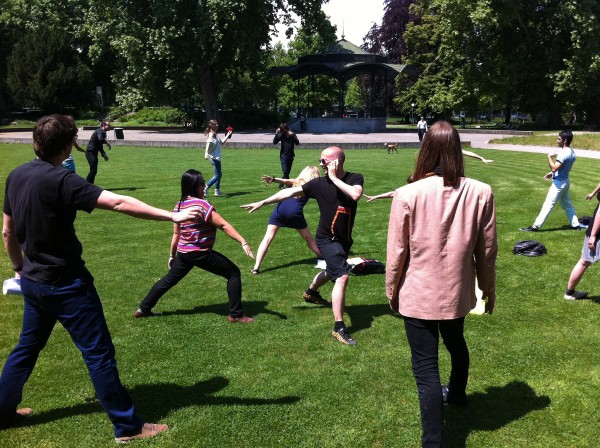
Net Walk
Net WalkWith a group of people, ask everyone to extend their arms out at full length. Ask everyone to space themselves so that their fingertips are just barely touching the fingertips of the people next to them. Trying to maintain this distance, walk through the city for ten minutes.
Designed by Eric Ellingsen & Christina Werner
Net WalkBitte alle Teilnehmer einer Gruppe die Arme auszustrecken. Alle positionieren sich so, dass sie gerade noch die Fingerspitzen der Personen neben sich berühren können. Haltet die Distanzen bei während Ihr für zehn Minuten durch die Stadt geht.
Konzipiert von Eric Ellingsen & Christina Werner

Map Walk
Map WalkCopy a map from another city. Use that map to find your way across the city you are currently in. Referring to the map, ask strangers where you are and to help you find the place you need to find.
Designed by Eric Ellingsen & Christina Werner
Map WalkErstelle eine Kopie des Stadtplan einer beliebigen Stadt X, um Dich in Stadt Y, in der Du Dich befindest, zu orientieren. Benutze diese Kopie zur Navigation, frage Fremde, wo Du Dich auf der Karte befinden könntest und wie Du anhand der Karte an Dein Ziel gelangen kannst.
Konzipiert von Eric Ellingsen & Christina Werner
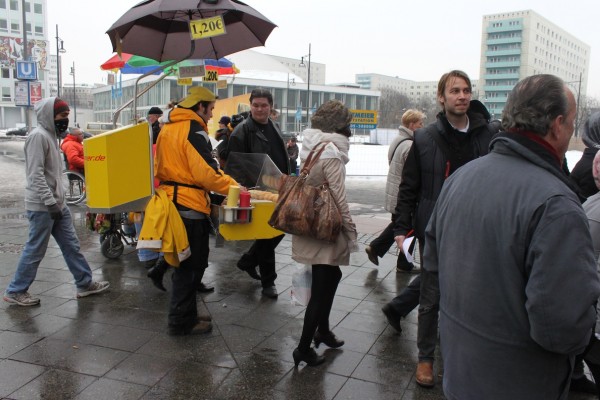
Smell Walk
Smell WalkStart some distance from where you need to go. Find your way by hitchhiking on different smells you encounter. If you lose one smell, ride on another until you arrive. Allow detours.
Designed by Eric Ellingsen & Christina Werner
Performed with Alice Waters
Smell Walk Lege ein bestimmtes Ziel fest. Folge den verschiedenen Gerüchen, auf die Du stösst. Verlierst Du einen Geruch aus der Nase, folge jeweils einem anderen bis Du Dein Ziel erreichst. Lass Umwege zu.
Konzipiert von Eric Ellingsen, Christina Werner
Unternommen mit Alice Waters
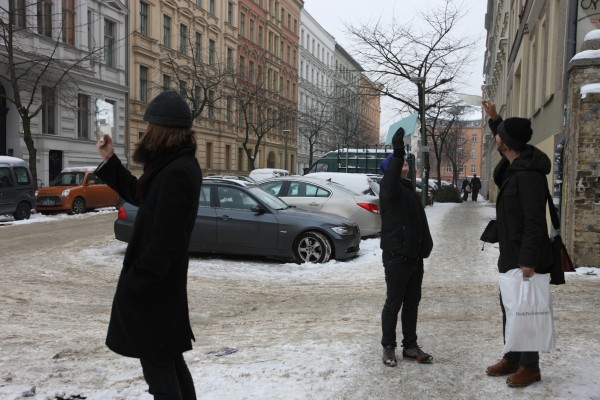
See Walk
See WalkWith a route in mind, use a mirror to orient yourself in reflected space. Walk the route by looking into the mirror to see where you are going.
Designed by Eric Ellingsen & Christina Werner
See Walk (Variation I)Work in teams of two or three: Use a mirror to orient yourself in reflected space. Walk the route by looking into the mirror to the other person to see where you are going.
See Walk (Variation II)As performed in See Walk, use a mirror to reflect on where you are going. In the two-person variation, find where you are going using someone elses reflection. Self-organize a choreography of slowness and seeing so that each person is simultaneously holding the other persons: way of seeing, where you are looking, where you are going, and how you get there together.
Walk: See WalkDefiniere einen Weg und ein Ziel. Orientiere Dich anhand des im Spiegel reflektierten Raums. Gehe dorthin, indem Du im Spiegel siehst wohin du gehst.
Konzipiert von Eric Ellingsen & Christina Werner
See Walk
See Walk (Variation I)Arbeitet zu zweit oder zu dritt. Orientiert Euch anhand des im Spiegel reflektierten Raums. Geht gemeinsam los. Orientiert Euch, indem Ihr den Spiegel der anderen nutzt, um zu sehen wohin Ihr geht.
See Walk (Variation II)Benutze wie beim See Walk einen Spiegel um Dich zu orientieren und zu sehen wohin Du gehst. In der Variante für zwei Personen benutzt jeder von Euch jeweils die Reflektion im Spiegel des anderen, um zu sehen wohin Ihr geht. Findet eine selbstorganisierte Choreographie von Verlangsamung und Orientierung, so dass jeder den anderen mit führt: wie Ihr seht, wohin Ihr schaut, wohin Ihr geht und wie Ihr dort hingelangt.
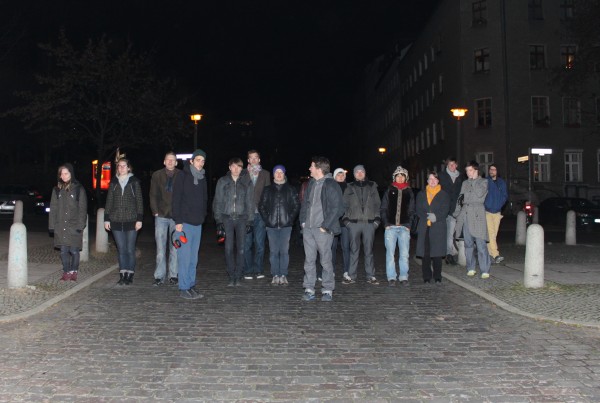
Slope Walk
Walk: Slope WalkStart on the top of a slope. Look down the slope trying to see it as level. Walk down the slope as if the slope is level.
Designed by Olafur Eliasson
Slope Walk (Variation I)Start on the top of a slope. Walk backwards down the slope.
Slope Walk (Variation I)
Slope Walk (Variation II)Start on the bottom of the slope. Look up the slope trying to see it as level. Walk up the slope as if the slope is level.
Slope Walk (Variation III)Close your eyes while walking up or down a slope. Imagine there is no slope.
Slope Walk (Variation III)
Slope Walk (Variation IV)Find a slope. Walk perpendicular to that slope.
Designed by Eric Ellingsen and Christina Werner
Slope WalkSuche eine Steigung. Sieh abwärts. Stelle Dir vor, das Gefälle ist eine ebene, horizontale Fläche. Laufe hangabwärts als wäre es eine ebene Fläche.
Konzipiert von Olafur Eliasson
Slope Walk (Variation I)Suche eine Steigung. Laufe rückwärts hangabwärts.
Slope Walk (Variation I)
Slope Walk (Variation II)Starte am Fuß einer Steigung. Sieh aufwärts. Stelle Dir vor, das Gefälle ist eine ebene, horizontale Fläche. Laufe hangaufwärts als wäre es eine ebene Fläche.
Slope Walk (Variation III)Gehe mit geschlossenen Augen eine Steigung hinauf oder hinunter. Stelle Dir vor es gibt kein Gefälle.
Slope Walk (Variation III)
Slope Walk (Variation IV)Suche Dir eine Steigung. Laufe diagonal zum Gefälle.
Konzipiert von Eric Ellingsen und Christina Werner

Estimation Walk (Time Your Space)
Estimation Walk (Time Your Space)Define a distance (300m; to the tree over there). Establish a slightly unreasonable amount of time to walk there (3 min; 30 minutes). Walk without stopping. Do not look at a watch as you walk. Try to arrive on time.
Designed by Eric Ellingsen & Christina Werner, in conjunction with an experiment by Jesper Dyrehauge on public space and architecture.
Part of the Space Activism Marathon
Estimation Walk (Time Your Space)
Estimation Walk (Time Your Space)Lege eine bestimmte Distanz (300 m) oder ein Ziel (bis zum nächsten Baum) fest; und ein etwas unrealistisches Zeitfenster (3 min; 30 min), um dort anzukommen. Gehe ohne anzuhalten. Schaue nicht auf die Uhr. Versuche Dein Ziel zeitgenau zu erreichen.
Konzipiert von Eric Ellingsen & Christina Werner.
Im Anschluss an ein Experiment von Jesper Dyrehauge zu öffentlichem Raum und Architektur.
Teil von Space Activism Marathon
Estimation Walk (Time Your Space)

Sound Walk (Line)
Walk: Sound Walk (Line)Line up a group of people. Saying the word "hello" to the person on both sides of you, stretch the line by increasing the volume of your "hello" as you move away from each other. See how far you can walk in audible range of "hellos” on both sides of you. If the line breaks, move closer to the last "hello". (Find a way to see and measure the whole sound line.)
Designed by Eric Ellingsen and Christina Werner
Walk: Sound Walk (Line)Bilde mit mehreren Personen eine Kette. Adressiere die Person rechts und links von Dir mit “Hallo”. Bewegt Euch auseinander, indem Ihr die Lautstärke der “Hallos” erhöht. Ist das “Hallo” auf einer Seite nicht mehr hörbar und die Kette an dieser Stelle unterbrochen, dann verkleinere den Abstand und schließe wieder an das nächste “Hallo” an. Seht wie weit Ihr Euch voneinander entfernen könnt, so dass Ihr das “Hallo” noch auf beiden Seiten hört. (Versucht, die ganze Kette zu sehen und zu dokumentieren.)
Konzipiert von Eric Ellingsen und Christina Werner
Sound Walk (Line)
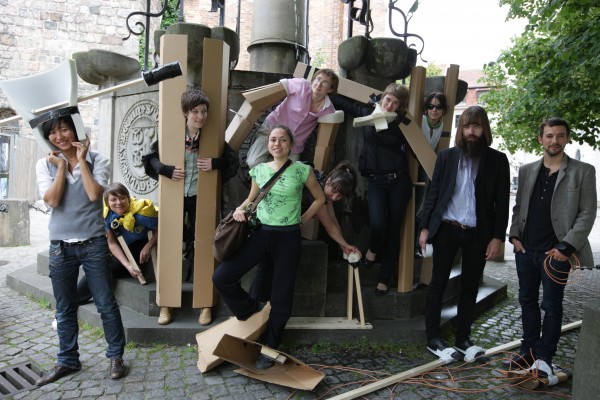
Antje Majewski and Alisa Savtchenko: Extended Body Walk
Extended Body WalkMake a simple prosthetic device (out of cardboard) to fit onto a particular part of your body. Attach the device. Set a destination relatively far away from where you start. Walk there.
Extended Body Walk
Prosthetic devices for Extended Body WalkWorkshop with Antje Majewski and Alisa Savtchenko
Extended Body WalkStelle eine einfache Prothese (aus Pappe) her, die an einen bestimmten Teil des Körpers passt. Befestige die Vorrichtung. Lege ein relativ weit entferntes Ziel fest. Gehe dorthin.
Extended Body Walk
Prothesen und Körpererweiterungen für den Extended Body Walk.Workshop mit Antje Majewski und Alisa Savtchenko
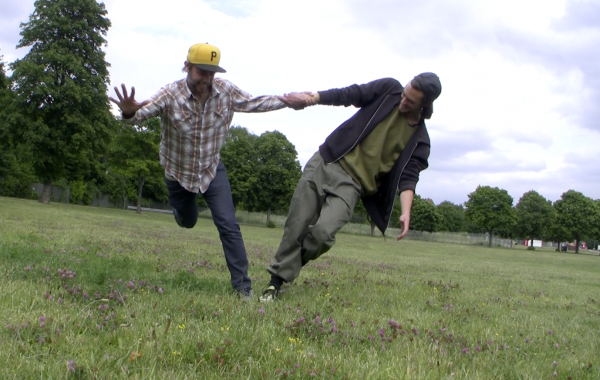
Nina Fischer & Maroan el Sani: Video Manuals
Fukushima Project Satellite: Institut für Raumexperimente; a workshop by Nina Fischer & Maroan el Sani in collaboration with Institut für Raumexperimente
Visit microblog
Fukashi Walk
Balance Walk
Swarm Walk
Backwards Walk
Fukushima Project Satellite: Institut für Raumexperimente Berlin, ein Workshop von Nina Fischer & Maroan el Sani in Zusammenarbeit mit Institut für Raumexperimente
Mikroblog ansehen
Fukashi Walk
Balance Walk
Swarm Walk
Backwards Walk
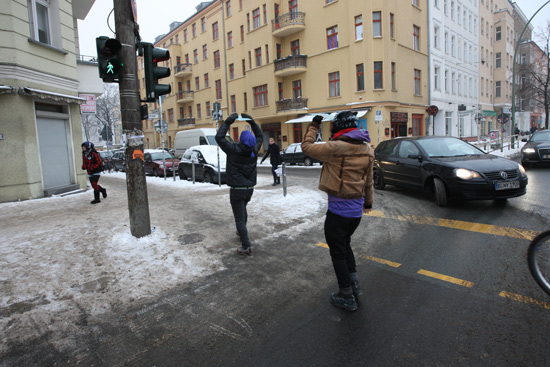
Walk Manuals
Backwards Walk:
Walk backwards for fifteen minutes through the city.
Balance Walk (Leaning Duets by Trisha Brown):
Find a partner, join hands and maintain a balance by tilting away from the other in an angle, composing a V, while the edges of your feet meet in the center. Take tentative steps in the same direction.
Barefoot Walk:
In the middle of winter, with ice or snow on the ground, find a place in public a few hundred meters from a warm inside environment. Take your shoes off. Walk until you start losing the feeling of your connection to the earth, then walk inside. Have towels and mildly warm water waiting for your feet.
Blind Walk:
Start in a place that is unfamiliar. One person is blindfold; one person guides. Start walking. The blindfolded person tries to make a loop back to where you started walking.
Blind Walk (Variation I):
Work as a team of two: one person is blindfolded; one person wears earplugs. Start walking, one guiding by sound, one by sight.
Diagonal Walk:
In a public space, walk only diagonal lines to get to a place 1km away.
Ever Walking Walk:
Pick a place across the city. Make your way, use public transportation to get there if you want. Do not stop walking no matter where you are – in the subway, while waiting etc – until you arrive.
Estimation Sound Walk:
In groups of two to five people, ask one person to stand still and close their eyes. Ask the others to stand next to the person with their eyes closed. Ask them to say here. Counting their footsteps, ask them to walk some distance away from the person standing still with their eyes closed, and then to stop. Ask them to say here again. Note, the person saying here should say the word with the same volume as they said it the first time. Have the person with their eyes closed guess how far away they have gone and to point to where they are.
Estimation Walk (Variation I):
Define a distance of 100m. The group starts walking, everyone walks in the same direction and stops after what they think is 100m.
Estimation Walk (Variation II)
Pick something around you and guess how many footsteps it would take between where you are standing and that thing. Walk that number of footsteps to that thing. Keep doing this for some time.
Estimation Walk (Time Your Space):
Define a distance (300m; to the tree over there). Establish a slightly unreasonable amount of time to walk there (3 min; 30 minutes). Walk without stopping. Do now look at a watch as you walk. Try to arrive on time.
Extended Body Walk:
Make a simple prosthetic device (out of cardboard) to fit onto a particular part of your body. Attach the device. Set a destination relatively far away from where you start. Walk there.
Fukashi Walk:
Pick a word or characters which has some significance to you. With a group of people, try to walk those letters or characters in a large scale and in a public space. Walk those letters or word over and over until you become the word you make.
Lay Down Line Walk:
With a group of people, lay down in a long line, head to toe, in a public space. Starting at the head of the line, ask the last person to stand up and run or walk to the other end of the line and lay down. Ask the new last person to stand up and walk or run to the end of the line. Repeat this with each end until everyone has walked or run at least three times.
Map Walk:
Copy a map from another city. Use that map to find your way across the city you are currently in. Referring to the map, ask strangers where you are and to help you find the place you need to find.
Measure Walk:
In public space, pick something at eye level or below, that is within easy walking distance. Estimate the size of that thing using your fingers and arms. Hold that measurement with your fingers or arms and walk to that thing. Keep doing this for some time.
Net Walk:
With a group of people, ask everyone to extend their arms out at full length. Ask everyone to space themselves so that their fingertips are just barely touching the fingertips of the people next to them. Trying to maintain this distance, walk through the city for ten minutes.
Periphery Walk:
Put your hands out to your side until you see your hands disappear. Keeping your hands at the boundary of your peripheral view, and keeping your head pointed straight while focused on your sides, walk through a part of the city.
See Walk:
With a route in mind, use a mirror to orient yourself in reflected space. Walk the route by looking into the mirror to see where you are going.
See Walk (Variation I):
Work in teams of two or three: Use a mirror to orient yourself in reflected space. Walk the route by looking into the mirror ot the other person to see where you are going.
See Walk, Double Reflection (A Two-Person Variation):
As performed in See Walk, use a mirror to reflect on where you are going. In the two-person variation, find where you are going using someone else’s reflection. Self-organize a choreography of slowness and seeing so that each person is simultaneously holding the other person’s way of seeing, where you are looking, where you are going, and how you get there together.
Silent Walk: With a group or alone, walk through part of a city without speaking for at least 30 minutes. While walking, give continuous and focused attention to the loudest sound you hear around you by looking in every direction in which you hear something.Slope Walk:
Start on the top of a slope. Look down the slope trying to see it as level. Walk down the slope as if the slope is level.
Slope Walk (Variation I):
Start on the top of a slope. Walk backwards down the slope.
Slope Walk (Variation II):
Start on the bottom of the slope. Look up the slope trying to see it as level. Walk up the slope as if the slope is level.
Slope Walk (Variation III):
Close your eyes while walking up or down a slope. Imagine there is no slope.
Slope Walk (Variation IV):
Find a slope. Walk perpendicular to that slope.
Slow Walk:
As a group, walk very ,very, very slowly for 15 minutes in public. Feel your weight on the ground. Feel your balance shift. Feel each part of the slow motion as it is distributed though your entire body. Don’t forget to breathe.
Slow Walk (Variation I):
Walk very very very very slowly with a group of people walking very very very very very slowly.
Slow Walk (Variation II):
Walk very very very very slowly.
Smell Walk:
Start some distance from where you need to go. Find your way by hitchhiking on different smells you encounter. If you lose one smell, ride on another until you arrive. Allow detours.
Sound Walk (Circle):
Start standing in a circle in a public space. Walk away from each other along different radii while saying “hello” to the people standing across from you. Keep walking your radius and screaming hello until you can no longer hear a “hello” from anyone in your circle saying hello. Walk back to the center saying hello.
Sound Walk (Line):
Line up a group of people. Saying the word ‘hello’ to the person on both sides of you, stretch the line by increasing the volume of your “hello” as you move away from each other. See how far you can walk in audible range of “hellos” on both sides of you. If the line breaks, move closer to the last “hello”. (Find a way to see and measure the whole sound line.)
Straight Walk:
Starting as a group in public space, each person picks a thing at some distance away. Try to walk in a straight line to that thing and back.
Take a Stand Walk:
Sit down while traveling on a form of public transportation. At some moment on the way, take off your shoes. Stand up in the place you are asked to sit. Keep standing there for some time while just being yourself.
Your Attention Span Walk:
On your way to somewhere else, focus on something around you. Look only at that thing. Think about nothing other than that thing. Let all other thoughts pass through you. When you arrive at that thing, pick another thing to focus on. Keep doing this over and over for some time.
Please send documentation of your walks to the Institut für Raumexperimente:
institut (at) raumexperimente.net
Backwards Walk:
Gehe für fünfzehn Minuten rückwärts durch die Stadt.
Balance Walk (Leaning Duets by Trisha Brown):
Finde einen Partner, haltet Euch an den Händen und stellt zwischen Euch die Balance her, indem Ihr Euch nach außen lehnt – ein V bildend – während sich die Kanten Eurer Füße bei jedem Schritt in der Mitte treffen. Geht vorsichtig in die gleiche Richtung.
Barefoot Walk:
Wenn im Winter der Boden mit Eis oder Schnee bedeckt ist, suche einen dem warmen Haus nahegelegenen, öffentlichen Ort. Ziehe deine Schuhe aus und laufe solange barfuß, bis du das Gefühl verlierst, mit der Erde verbunden zu sein. Kehre dann ins Warme zurück. Halte Handtücher und warmes Wasser für deine Füße bereit.
Blind Walk:
Startet an einem Euch unbekannten Ort. Eine Person hat verbundene Augen, eine Person führt. Lauft los. Die Person mit verbunden Augen versucht einen Bogen zu schlagen und zum Ausgangsort zurückzufinden.
Blind Walk (Variation I):
Bildet einer Zweierteam: Eine Person hat verbundene Augen, ein Person benutzt Ohrstöpsel. Lauft los. Einer führt sehend, der andere führt hörend.
Diagonal Walk:
Gehe in diagonalen Linien durch den Stadtraum zu einem Ort, der einen Kilometer entfernt liegt.
Estimation Sound Walk:
In einer Gruppe von zwei bis fünf Personen schließt einer die Augen. Die anderen stellen sich direkt um diese Person herum, jeder von ihnen sagt nacheinander „Hier“ und entfernt sich dann um eine beliebige Schrittzahl von der Person in der Mitte und wiederholt dann ein „Hier“ in der gleichen Lautstärke wie zuvor. Die Person mit den geschlossenen Augen rät wieviele Schritte sich die anderen jeweils entfernt haben und zeigt noch immer mit geschlossenen Augen an, wo die anderen jeweils stehen.
Estimation Walk (Variation I):
Lege eine Distanz von 100 m fest. Die Gruppe startet gemeinsam, alle gehen in dieselbe Richtung. Jeder stopt, wenn er denkt, dass er 100 m weit gegangen ist.
Estimation Walk (Variation II):
Wähle eine Gegenstand oder einen festen Bezugspunkt aus und schätze wieviele Schritte Dich von diesem trennen. Gehe die geschätze Anzahl von Schritten darauf zu. Wiederhole dies für eine gewisse Zeit.
Estimation Walk (Time Your Space):
Lege eine bestimmte Distanz (300 m) oder ein Ziel (bis zum nächsten Baum) fest; und ein etwas unrealistisches Zeitfenster (3 min; 30 min), um dort anzukommen. Gehe ohne anzuhalten. Schaue nicht auf die Uhr. Versuche Dein Ziel zeitgenau zu erreichen.
Ever Walking Walk:
Lege ein bliebiges Ziel am anderen Ende der Stadt fest. Mach Dich auf den Weg, benutze öffentliche Verkehrsmittel, wenn Du willst. Hör nicht auf zu gehen, laufe ununterbrochen, egal wo Du gerade bist – in der U-Bahn, beim Warten, etc. – bis Du dort ankommst.
Extended Body Walk:
Stelle eine einfache Prothese (aus Pappe) her, die an einen bestimmten Teil des Körpers passt. Befestige die Vorrichtung. Lege ein relativ weit entferntes Ziel fest. Gehe dorthin.
Fukashi Walk:
Wähle ein Wort, das für Dich von Bedeutung ist. Stell Dir das Wort in großem Maßstab vor und laufe die imaginären Buchstaben des Wortes mit einer Gruppe von Leuten ab. Erlauft Euch diese Buchstaben oder Worte bis Ihr zu den Wörtern werdet, die Ihr bildet.
Lay Down Line Walk:
Legt Euch in einer Reihe – Kopf an Fuß – im öffentlichen Raum auf den Boden. Die letzte Person in der Reihe, steht auf und rennt oder geht zum Anfang und legt sich dort hin. Die nun letzte Person steht auf und läuft zum Beginn der Schlange und legt sich der Länge nach hin. Wiederholt das solange bis jeder mindestens drei an der Reihe war.
Map Walk:
Mach eine Kopie des Stadtplan einer beliebigen Stadt X, um Dich in Stadt Y, in der Du Dich befindest, zu orientieren. Benutze diese Kopie zur Navigation, frage Fremde, wo Du Dich auf der Karte befinden könntest und wie Du anhand der Karte an Dein Ziel gelangen kannst.
Measure Walk:
Wähle einen Gegenstand auf Augenhöhe oder darunter, der in an angemessener Distanz zu sehen ist. Schließ ein Auge und miss die Größe des Gegenstands mit Daumen und Zeigefinger. Halte diesen Messabstand von Daumen und Zeigefinger bei und nähere Dich dem Gegenstand bis Du ihn berühren kannst. Wiederhole dies für beliebige Zeit.
Net Walk:
Bitte alle Teilnehmer einer Gruppe die Arme auszustrecken. Alle positionieren sich so, dass sie gerade noch die Fingerspitzen der Personen neben sich berühren können. Haltet die Distanzen bei während Ihr für zehn Minuten durch die Stadt geht.
Periphery Walk:
Strecke deine Arme soweit seitwärts aus, dass du deine Hände verschwinden siehst. Halte die Hände an der Peripherie deiner Sicht und den Kopf nach vorn gerichtet während Du die Seiten fokussierst. Laufe so durch die Stadt.
Slow Walk:
Geht als Gruppe ganz, ganz, ganz langsam für 15 Minuten im öffentlichen Raum. Spüre Deine Gewichtsverlagerung bei jedem Schritt. Spüre wie Deine Balance sich verschiebt. Spüre wie jeder Moment des verlangsamten Bewerbungsablaufs sich auf Deinen gesamten Körper auswirkt. Vergiss nicht zu atmen.
Slow Walk (Variation I):
Gehe sehr sehr sehr sehr langsam in einer Gruppe von Leuten, die sehr sehr sehr sehr sehr langsam geht.
Slow Walk (Variation II):
Gehe sehr sehr sehr sehr langsam.
Smell Walk:
Lege ein bestimmtes Ziel fest. Folge den verschiedenen Gerüchen, auf die Du stösst. Verlierst Du einen Geruch aus der Nase, folge jeweils einem anderen bis Du Dein Ziel erreichst. Lass Umwege zu.
See Walk:
Definiere einen Weg und ein Ziel. Orientiere Dich anhand des im Spiegel reflektierten Raums. Gehe dorthin, indem Du im Spiegel siehst wohin du gehst.
See Walk (Variation I):
Arbeitet zu zweit oder zu dritt. Orientiert Euch anhand des im Spiegel reflektierten Raums. Geht gemeinsam los. Orientiert Euch, indem Ihr den Spiegel der anderen nutzt, um zu sehen wohin Ihr geht.
See Walk, Double Reflection (A Two-Person Variation):
Benutze wie beim See Walk einen Spiegel um Dich zu orientieren und zu sehen wohin Du gehst. In der Variante für zwei Personen benutzt jeder von Euch jeweils die Reflektion im Spiegel des anderen, um zu sehen wohin Ihr geht. Findet eine selbstorganisierte Choreographie von Verlangsamung und Orientierung, so dass jeder den anderen mit führt: wie Ihr seht, wohin Ihr schaut, wohin Ihr geht und wie Ihr dort hingelangt.
Silent Walk: Laufe allein oder mit einer Gruppe für mindestens eine halbe Stunde schweigend durch eine Stadt. Richtet während des Laufens eure Aufmerksamkeit beständig auf das lauteste Geräusch in der Umgebung und schaut in dessen Richtung.
Slope Walk:
Suche eine Steigung. Sieh abwärts. Stelle Dir vor, das Gefälle ist eine ebene, horizontale Fläche. Laufe hangabwärts als wäre es eine ebene Fläche.
Slope Walk (Variation I):
Suche eine Steigung. Laufe rückwärts hangabwärts.
Slope Walk (Variation II):
Starte am Fuß einer Steigung. Sieh aufwärts. Stelle Dir vor, das Gefälle ist eine ebene, horizontale Fläche. Laufe hangaufwärts als wäre es eine ebene Fläche.
Slope Walk (Variation III):
Gehe mit geschlossenen Augen eine Steigung hinauf oder hinunter. Stelle Dir vor es gibt kein Gefälle.
Slope Walk (Variation IV):
Suche Dir eine Steigung. Laufe diagonal zum Gefälle.
Sound Walk (Line):
Bilde mit mehreren Personen eine Kette. Adressiere die Person rechts und links von Dir mit “Hallo”. Bewegt Euch auseinander, indem Ihr die Lautstärke der “Hallos” erhöht. Ist das “Hallo” auf einer Seite nicht mehr hörbar und die Kette an dieser Stelle unterbrochen, dann verkleinere den Abstand und schließe wieder an das nächste “Hallo” an. Seht wie weit Ihr Euch voneinander entfernen könnt, so dass Ihr das “Hallo” noch auf beiden Seiten hört. (Versucht, die ganze Kette zu sehen und zu dokumentieren.)
Sound Walk (Circle):
Bilde mit mehreren Teilnehmern einen Kreis. Sage “Hallo” zur Person, die Dir im Kreis gegenübersteht und enferne Dich langsam rückwärtsgehend von ihr. Vergrößere den Abstand und damit den Kreisradius und rufe lauter “Hallo” bis du das “Hallo” der anderen Personen im Kreis nicht mehr hören kannst. Laufe zurück zum Kreismittelpunkt und sage “Hallo”.
Straight Walk:
Jeder Teilnehmer der Gruppe wählt einen Gegenstand in beliebiger Distanz aus. Alle starten gleichzeitig und versuchen auf einer gerade Linie zum jeweiligen Gegenstand und wieder zurück zu laufen.
Take a Stand Walk:
Fahre mit öffentlichen Verkehrsmitteln und setzt Dich während der Fahrt auf einen freien Platz. Irgendwann ziehst Du die Schuhe aus. Stelle Dich auf Deinen Sitzplatz. Stehe dort für eine Weile. Sei Du selbst.
Your Attention Span Walk:
Fokusiere etwas in Deinem Blickfeld während Du irgendwohin gehst. Betrachte nur dieses. Versuche an nichts anderes zu denken. Lass die anderen Gedanken vorbei ziehen. Wenn Du die gewählte Stelle passiert hast, suche Dir einen neuen Fokuspunkt. Wiederhole das wieder und wieder während Du weiter gehst.
Wir freuen uns über die Zusendungen der Dokumentationen Eurer Walks:
institut (at) raumexperimente.net
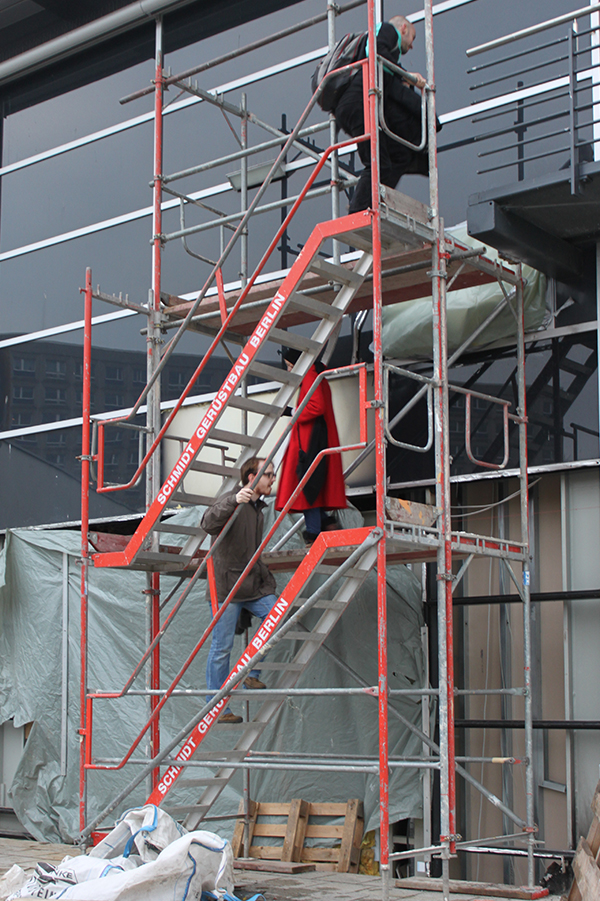
Ever Walking
Walk: Ever WalkingPick a place across the city. Make your way, use public transportation to get there if you want. Do not stop walking no matter where you are – in the subway, while waiting etc – until you arrive.
Designed by Eric Ellingsen & Christina Werner with Euan Williams & Quynh Vantu
Walk: Ever WalkingLege ein bliebiges Ziel am anderen Ende der Stadt fest. Mach Dich auf den Weg, benutze öffentliche Verkehrsmittel, wenn Du willst. Hör nicht auf zu gehen, laufe ununterbrochen, egal wo Du gerade bist – in der U-Bahn, beim Warten, etc. – bis Du dort ankommst.
Konzipiert von Eric Ellingsen & Christina Werner mit Euan Williams & Quynh Vantu
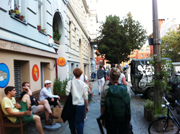
Backwards Walk
Walk: Backwards WalkWalk backwards for fifteen minutes through the city.
Designed by Eric Ellingsen & Christina Werner
Backwards Walk, performed with Institut für Landschaftsarchitektur ETH Zurich, 7 July 2011
Backwards Walk with Nina Fischer & Maroan el Sani, 14 June 2012
Walk: Backwards WalkGehe für fünfzehn Minuten rückwärts durch die Stadt.
Konzipiert von Eric Ellingsen & Christina Werner
Backwards Walk, Durchgeführt mit dem Institut für Landschaftsarchitektur ETH Zurich, 7. Juli 2011
Backwards Walk mit Nina Fischer & Maroan el Sani, 14. Juni 2012
